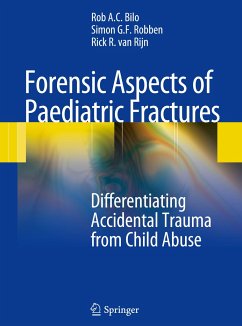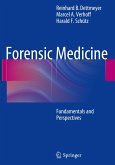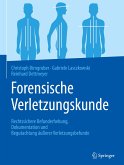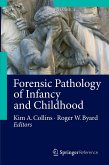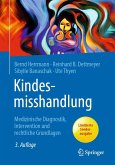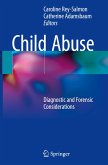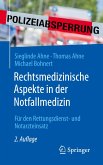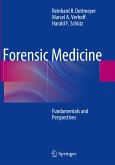Fractures are a common finding in children and it is estimated that 2.1% of all children will suffer at least one fracture before the age of 16. With young children in particular, the question may arise if this is related to child abuse. The aim of this book is to help physicians involved in child abuse cases to interpret radiological findings in light of the forensic circumstances under which they occurred. The authors present up-to-date literature related to the mechanisms underlying non-accidental cases of trauma.
In this book not only the radiological findings in child-abuse are discussed, but more importantly, these findings are analyzed from a forensic perspective. Careful attention is paid to evidence regarding reported trauma mechanisms and their clinical outcome; for example, can a fall from a couch result in a femoral fracture, and if not, where is the supporting evidence?
Hinweis: Dieser Artikel kann nur an eine deutsche Lieferadresse ausgeliefert werden.
In this book not only the radiological findings in child-abuse are discussed, but more importantly, these findings are analyzed from a forensic perspective. Careful attention is paid to evidence regarding reported trauma mechanisms and their clinical outcome; for example, can a fall from a couch result in a femoral fracture, and if not, where is the supporting evidence?
Hinweis: Dieser Artikel kann nur an eine deutsche Lieferadresse ausgeliefert werden.
From the reviews:
"This new book is a welcome addition to the field of child abuse. It is a must-read for anyone specializing in the field of intentional injury and is a reader-friendly and valuable reference for clinicians who assess and treat children with fractures. The table of contents is detailed, allowing readers to quickly find and investigate topics of interest. ... is easy to read, makes good use of tables, and includes excellent graphics and a vast array of images embedded within the chapters." (Stephen B. Freedman, Journal of the American Medical Association, Vol. 304 (9), September, 2010)
"A fantastic new book that is a prime example of contemporary scientific literature. ... is very well illustrated with contemporary radiographs, CT scans and MRIs. ... The text is outstanding. ... a wonderful addition to any radiology or pediatric library. ... an outstanding resource for radiologists, pediatricians and child abuse experts. ... prosecutors and defense lawyers will findthis an invaluable book for preparing their cases. Students and researchers might find this a very helpful resource as well." (Brent H. Adler, Pediatric Radiology, August, 2010)
"The publishers use their standard format of numerically organised chapters that make the text particularly easy to follow. ... The organisation and presentation of this text make it an excellent addition to the libraries of those who are concerned in the imaging of cases of suspected non-accidental injury in children." (Jamie Beck, RAD Magazine, January, 2011)
"The intended audience is all those who are involved in the initial diagnosis of child abuse, including pediatricians, emergency room physicians, and radiologists. The textbook is well written, concise, and well organized. ... covers both neurologic and musculoskeletal manifestations of child abuse, with an emphasis on clinical presentation. ... The images and illustrations are appropriately sized and of a high resolution. ... an appropriate reference source for both clinicians and radiologists who are involved in the diagnosis of child abuse." (J. Herman Kan, Radiology, Vol. 259 (3), June, 2011)
"The book in review addresses the problem, showing in detail the multi-faceted spectrum of non-accidental fractures and their related forensic aspects. ... Image reproduction is quite good and the use of detailed reproduction or photo-enhancement to improve fracture visibility should be praised. ... This is a must-have book, particularly in Italy where non-accidental fractures are not commonly encountered and described ... . The book is strongly recommended to radiologists ... orthopaedics, paediatricians, legal medicine physicians, lawyers and judges." (Giampiero Beluffi, Radiologia Medica, Vol. 116, 2011)
"The book in review addresses the problem, showing in detail the multi-faceted spectrum of non-accidental fractures and their related forensic aspects. ... This is a must-have book, particularly in Italy where non-accidental fractures are not commonly encountered and described ... The book is strongly recommended to radiologists (a copy should be available in all Emergency Departments), orthopaedics, paediatricians, legal medicine physicians, lawyers and judges." (Giampiero Beluffi, Radiologia Medica, Vol. 116, 2011)
"This new book is a welcome addition to the field of child abuse. It is a must-read for anyone specializing in the field of intentional injury and is a reader-friendly and valuable reference for clinicians who assess and treat children with fractures. The table of contents is detailed, allowing readers to quickly find and investigate topics of interest. ... is easy to read, makes good use of tables, and includes excellent graphics and a vast array of images embedded within the chapters." (Stephen B. Freedman, Journal of the American Medical Association, Vol. 304 (9), September, 2010)
"A fantastic new book that is a prime example of contemporary scientific literature. ... is very well illustrated with contemporary radiographs, CT scans and MRIs. ... The text is outstanding. ... a wonderful addition to any radiology or pediatric library. ... an outstanding resource for radiologists, pediatricians and child abuse experts. ... prosecutors and defense lawyers will findthis an invaluable book for preparing their cases. Students and researchers might find this a very helpful resource as well." (Brent H. Adler, Pediatric Radiology, August, 2010)
"The publishers use their standard format of numerically organised chapters that make the text particularly easy to follow. ... The organisation and presentation of this text make it an excellent addition to the libraries of those who are concerned in the imaging of cases of suspected non-accidental injury in children." (Jamie Beck, RAD Magazine, January, 2011)
"The intended audience is all those who are involved in the initial diagnosis of child abuse, including pediatricians, emergency room physicians, and radiologists. The textbook is well written, concise, and well organized. ... covers both neurologic and musculoskeletal manifestations of child abuse, with an emphasis on clinical presentation. ... The images and illustrations are appropriately sized and of a high resolution. ... an appropriate reference source for both clinicians and radiologists who are involved in the diagnosis of child abuse." (J. Herman Kan, Radiology, Vol. 259 (3), June, 2011)
"The book in review addresses the problem, showing in detail the multi-faceted spectrum of non-accidental fractures and their related forensic aspects. ... Image reproduction is quite good and the use of detailed reproduction or photo-enhancement to improve fracture visibility should be praised. ... This is a must-have book, particularly in Italy where non-accidental fractures are not commonly encountered and described ... . The book is strongly recommended to radiologists ... orthopaedics, paediatricians, legal medicine physicians, lawyers and judges." (Giampiero Beluffi, Radiologia Medica, Vol. 116, 2011)
"The book in review addresses the problem, showing in detail the multi-faceted spectrum of non-accidental fractures and their related forensic aspects. ... This is a must-have book, particularly in Italy where non-accidental fractures are not commonly encountered and described ... The book is strongly recommended to radiologists (a copy should be available in all Emergency Departments), orthopaedics, paediatricians, legal medicine physicians, lawyers and judges." (Giampiero Beluffi, Radiologia Medica, Vol. 116, 2011)

